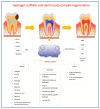Hydrogels and Dentin-Pulp Complex Regeneration: From the Benchtop to Clinical Translation
- PMID: 33316886
- PMCID: PMC7763835
- DOI: 10.3390/polym12122935
Hydrogels and Dentin-Pulp Complex Regeneration: From the Benchtop to Clinical Translation
Abstract
Dentin-pulp complex is a term which refers to the dental pulp (DP) surrounded by dentin along its peripheries. Dentin and dental pulp are highly specialized tissues, which can be affected by various insults, primarily by dental caries. Regeneration of the dentin-pulp complex is of paramount importance to regain tooth vitality. The regenerative endodontic procedure (REP) is a relatively current approach, which aims to regenerate the dentin-pulp complex through stimulating the differentiation of resident or transplanted stem/progenitor cells. Hydrogel-based scaffolds are a unique category of three dimensional polymeric networks with high water content. They are hydrophilic, biocompatible, with tunable degradation patterns and mechanical properties, in addition to the ability to be loaded with various bioactive molecules. Furthermore, hydrogels have a considerable degree of flexibility and elasticity, mimicking the cell extracellular matrix (ECM), particularly that of the DP. The current review presents how for dentin-pulp complex regeneration, the application of injectable hydrogels combined with stem/progenitor cells could represent a promising approach. According to the source of the polymeric chain forming the hydrogel, they can be classified into natural, synthetic or hybrid hydrogels, combining natural and synthetic ones. Natural polymers are bioactive, highly biocompatible, and biodegradable by naturally occurring enzymes or via hydrolysis. On the other hand, synthetic polymers offer tunable mechanical properties, thermostability and durability as compared to natural hydrogels. Hybrid hydrogels combine the benefits of synthetic and natural polymers. Hydrogels can be biofunctionalized with cell-binding sequences as arginine-glycine-aspartic acid (RGD), can be used for local delivery of bioactive molecules and cellularized with stem cells for dentin-pulp regeneration. Formulating a hydrogel scaffold material fulfilling the required criteria in regenerative endodontics is still an area of active research, which shows promising potential for replacing conventional endodontic treatments in the near future.
Keywords: dental; hydrogels; polymers; regeneration; stem cells; tissue engineering.
Conflict of interest statement
The authors declare no conflict of interest.
Figures
References
-
- Fahmy S.H., Hassanien E.E.S., Nagy M.M., El Batouty K.M., Mekhemar M., Fawzy El Sayed K., Hassanein E.H., Wiltfang J., Dorfer C. Investigation of the regenerative potential of necrotic mature teeth following different revascularisation protocols. Aust. Endod. J. 2017;43:73–82. doi: 10.1111/aej.12210. - DOI - PubMed
-
- Fawzy El-Sayed K.M., Elsalawy R., Ibrahim N., Gadalla M., Albargasy H., Zahra N., Mokhtar S., El Nahhas N., El Kaliouby Y., Dorfer C.E. The Dental Pulp Stem/Progenitor Cells-Mediated Inflammatory-Regenerative Axis. Tissue Eng. Part B Rev. 2019;25:445–460. doi: 10.1089/ten.teb.2019.0106. - DOI - PubMed
Publication types
LinkOut - more resources
Full Text Sources




